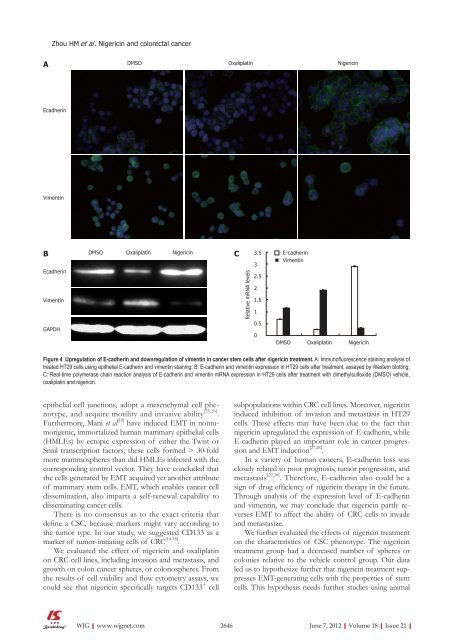Evidence base and patients' perspective - World Journal of ...
Evidence base and patients' perspective - World Journal of ...
Evidence base and patients' perspective - World Journal of ...
Create successful ePaper yourself
Turn your PDF publications into a flip-book with our unique Google optimized e-Paper software.
A<br />
B<br />
Ecadherin<br />
Vimentin<br />
GAPDH<br />
Zhou HM et al �� Nigericin <strong>and</strong> colorectal cancer<br />
Ecadherin<br />
Vimentin<br />
epithelial cell junctions, adopt a mesenchymal cell phenotype,<br />
<strong>and</strong> acquire motility <strong>and</strong> invasive ability [25,26] .<br />
Furthermore, Mani et al [10] have induced EMT in nontumorigenic,<br />
immortalized human mammary epithelial cells<br />
(HMLEs) by ectopic expression <strong>of</strong> either the Twist or<br />
Snail transcription factors; these cells formed > 30-fold<br />
more mammospheres than did HMLEs infected with the<br />
corresponding control vector. They have concluded that<br />
the cells generated by EMT acquired yet another attribute<br />
<strong>of</strong> mammary stem cells. EMT, which enables cancer cell<br />
dissemination, also imparts a self-renewal capability to<br />
disseminating cancer cells.<br />
There is no consensus as to the exact criteria that<br />
define a CSC, because markers might vary according to<br />
the tumor type. In our study, we suggested CD133 as a<br />
marker <strong>of</strong> tumor-initiating cells <strong>of</strong> CRC [14-18] .<br />
We evaluated the effect <strong>of</strong> nigericin <strong>and</strong> oxaliplatin<br />
on CRC cell lines, including invasion <strong>and</strong> metastasis, <strong>and</strong><br />
growth on colon cancer spheres, or colonospheres. From<br />
the results <strong>of</strong> cell viability <strong>and</strong> flow cytometry assays, we<br />
could see that nigericin specifically targets CD133 + cell<br />
WJG|www.wjgnet.com<br />
DMSO Oxaliplatin Nigericin<br />
DMSO Oxaliplatin Nigericin<br />
C<br />
Relative mRNA levels<br />
3��5<br />
3<br />
2��5<br />
2<br />
1��5<br />
1<br />
0��5<br />
0<br />
E-cadherin<br />
Vimentin<br />
DMSO Oxaliplatin Nigericin<br />
Figure 4 Upregulation <strong>of</strong> E-cadherin <strong>and</strong> downregulation <strong>of</strong> vimentin in cancer stem cells after nigericin treatment. A: Immun<strong>of</strong>luorescence staining analysis <strong>of</strong><br />
treated HT29 cells using epithelial E-cadherin <strong>and</strong> vimentin staining; B: E-cadherin <strong>and</strong> vimentin expression in HT29 cells after treatment, assayed by Western blotting;<br />
C: Real-time polymerase chain reaction analysis <strong>of</strong> E-cadherin <strong>and</strong> vimentin mRNA expression in HT29 cells after treatment with dimethylsulfoxide (DMSO) vehicle,<br />
oxaliplatin <strong>and</strong> nigericin.<br />
subpopulations within CRC cell lines. Moreover, nigericin<br />
induced inhibition <strong>of</strong> invasion <strong>and</strong> metastasis in HT29<br />
cells. These effects may have been due to the fact that<br />
nigericin upregulated the expression <strong>of</strong> E-cadherin, while<br />
E-cadherin played an important role in cancer progression<br />
<strong>and</strong> EMT induction [27,28] .<br />
In a variety <strong>of</strong> human cancers, E-cadherin loss was<br />
closely related to poor prognosis, tumor progression, <strong>and</strong><br />
metastasis [29,30] . Therefore, E-cadherin also could be a<br />
sign <strong>of</strong> drug efficiency <strong>of</strong> nigericin therapy in the future.<br />
Through analysis <strong>of</strong> the expression level <strong>of</strong> E-cadherin<br />
<strong>and</strong> vimentin, we may conclude that nigericin partly reverses<br />
EMT to affect the ability <strong>of</strong> CRC cells to invade<br />
<strong>and</strong> metastasize.<br />
We further evaluated the effects <strong>of</strong> nigericin treatment<br />
on the characteristics <strong>of</strong> CSC phenotype. The nigericin<br />
treatment group had a decreased number <strong>of</strong> spheres or<br />
colonies relative to the vehicle control group. Our data<br />
led us to hypothesize further that nigericin treatment suppresses<br />
EMT-generating cells with the properties <strong>of</strong> stem<br />
cells. This hypothesis needs further studies using animal<br />
2646 June 7, 2012|Volume 18|Issue 21|

















